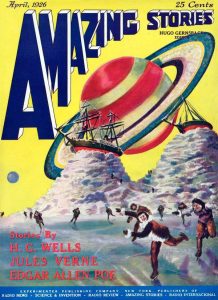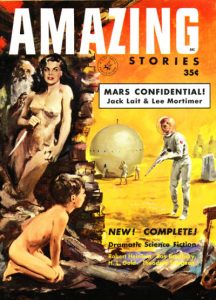 It was hard to miss the first issue of AMAZING STORIES on the newsstand. Letter-size, larger than the typical pulp magazine, with three-dimensional block letters trailing across its masthead and a bright yellow backdrop that framed an alien landscape and a bright red, ringed planet and small moon, the magazine certainly stood out on the sales rack. Frank R. Paul was the artist.
It was hard to miss the first issue of AMAZING STORIES on the newsstand. Letter-size, larger than the typical pulp magazine, with three-dimensional block letters trailing across its masthead and a bright yellow backdrop that framed an alien landscape and a bright red, ringed planet and small moon, the magazine certainly stood out on the sales rack. Frank R. Paul was the artist.
The names on the front cover of the magazine’s early issues were also major selling points: Edgar Allan Poe, Jules Verne, H. G. Wells, Garrett P. Serviss, Edgar Rice Burroughs, A. Merritt, and others. It was just as Gernsback wrote in his editorial for the pulp’s first issue: “By ‘scientifiction’ I mean the Jules Verne, H. G. Wells, and Edgar Allan Poe type story — a charming romance intermingled with scientific fact and prophetic vision.” That is what the readers of AMAZING STORIES sought: “They wanted to be entertained, to escape, to experience that sense of wonder that good visionary fiction brought.” (Mike Ashley in THE TIME MACHINES).
Using stories drawn from the Munsey magazines, BLUE BOOK, THE STRAND, and other sources, Gernsback offered reprints of science-fiction classics, eventually coupling these with new stories often generated through contests. Through these competitions, Gernsback began to acquire a stable of new writers willing and able to write scientifiction: Miles J. Breur, Clare Winger Harris, David H. Keller, S. P. Meek, A. Hyatt Verrill, Harl Vincent, and others. Through his letter column, entitled “Discussions,” he reeled his readers into his world of wonder.
Within months, the new specialty magazine was selling over 100,000 copies of each issue. In establishing the first specialized science-fiction magazine, Gernsback had tapped a vein of wonder, shared by lonely individuals prone to “imaginative flights of fancy.” Next would come AMAZING STORIES ANNUAL, published in the summer of 1927 and featuring Edgar Rice Burroughs’ “The Mastermind of Mars.” AMAZING STORIES QUARTERLY followed in the winter of 1928. Then, in the August 1928 number of AMAZING STORIES, Gernsback introduced his readers to E. E. “Doc” Smith’s “The Skylark of Space” and Philip Francis Nowlan’s “Armageddon—2419 AD,” the first tale to feature Buck Rogers. These two “space operas” would color science fiction for well over a decade, turning it into “that crazy Buck Rogers stuff.”
Not one of the penny dreadfuls, dime novels, or pulp magazines published from the turn to the middle of the twentieth century, was created in isolation. There was a great, sometimes troubling, world buzzing around the butcher, the baker, the cop, the bobby-soxer, the factory worker, the Gibson girl, and the kid as they flipped a coin on the counter, left the newsstand, and walked home with a copy of magic in their hands.
 It was certainly true of the magazine that transmogrified scientifiction into science fiction: AMAZING STORIES. Through war, police actions, political upheaval; through reprints and originals; though a remarkable set of editors, AMAZING persevered into the twenty-first century.
It was certainly true of the magazine that transmogrified scientifiction into science fiction: AMAZING STORIES. Through war, police actions, political upheaval; through reprints and originals; though a remarkable set of editors, AMAZING persevered into the twenty-first century.
Join PulpFest 2016 at 8:45 PM on Friday, July 22, as we welcome Joseph Coluccio, president of the Pittsburgh Area Fantasy and Science Fiction Club, to our programming stage in the Union Rooms on the second floor of the Hyatt Regency Columbus for a look at AMAZING STORIES during the pulp era. It is Mr. Coluccio’s intention to consider the history — to about mid-century — of the content found in the pages of AMAZING STORIES, not in the context of the world at large, but in comparison to the rich popular culture of the time — science, radio, film art, and literature — that surrounded and influenced the magazine. Cover art, words and anecdotes are all that are left of those early, amazing years. Through a series of sometimes exciting, sometimes disastrous editorial decisions, AMAZING STORIES reflected changes right back into the flowing current of everyday taste. Relive those times through the words of Hugo Gernsback, T. O’Connor Sloane, Raymond A. Palmer and Howard Browne, brought to you by PARSEC‘s Joseph Coluccio.
Join “Summer’s AMAZING Pulp Con” as we salute the 90th anniversary of the first continuing science fiction magazine. The convention will take place from July 21 through July 24 in the Columbus, Ohio Arena district at the Hyatt Regency hotel and the city’s spacious convention center. You’ll have a FANTASTIC time.
(Hugo Gernsback edited and published AMAZING STORIES from April 1926 through April 1929. Plowing money into other interests and paying an extremely hefty salary to both himself and his brother, Hugo Gernsback filed for bankruptcy in early 1929. Afterward, T. O’Conor Sloane — who had assisted Gernsback from the start — became the magazine’s editor until the April 1938 issue. Sloane was far from being a visionary; he thought space travel was impossible.
Ziff-Davis took over the magazine with its April 1938 number featuring Ray Palmer as editor. The new editor transformed AMAZING STORIES into a juvenile magazine, establishing a stable of authors to write fiction aimed at the youth market. Toward the end of his editorial reign, Palmer started “The Shaver Mystery,” a hoax involving an evil race that causes all of mankind’s problems from their home underground. Palmer’s last issue was dated December 1949. In later years, he became involved with UFOs and similar topics while publishing FATE magazine.
 Howard Browne, a Palmer assistant, assumed the editorship in January 1950. Primarily interested in mystery fiction, Browne nevertheless turned AMAZING STORIES around, directing it toward an adult audience. It became a digest magazine — featuring cover art by Barye Phillps on its first issue — with its April/May 1953 number. Browne left the magazine following its August 1956 number. He was succeeded by Paul Fairman and the talented Cele Goldsmith. Ms. Goldsmith managed the magazine from March 1957 through June 1965, during which time it garnered a great deal of respect.
Howard Browne, a Palmer assistant, assumed the editorship in January 1950. Primarily interested in mystery fiction, Browne nevertheless turned AMAZING STORIES around, directing it toward an adult audience. It became a digest magazine — featuring cover art by Barye Phillps on its first issue — with its April/May 1953 number. Browne left the magazine following its August 1956 number. He was succeeded by Paul Fairman and the talented Cele Goldsmith. Ms. Goldsmith managed the magazine from March 1957 through June 1965, during which time it garnered a great deal of respect.
The Ultimate Publishing company, headed by Sol Cohen, began publishing the magazine with its August 1965 issue. Joseph Wrzos was its first editor, followed by Harry Harrison, Barry Malzberg, Ted White, and Elinor Mavor. The magazine was acquired by TSR Hobbies in March 1982, with Mavor continuing as editor. George Scithers became the editor with the November 1982 issue. Later editors included Patrick Price, Kim Mohan, and Jeff Berkwits. Its last issue was published in March 2005 with Paizo Publishing in charge.
In July 2012, longtime science-fiction fan Steve Davidson revived AMAZING STORIES as an online magazine. You can find it at http://amazingstoriesmag.com/. Its first issue— dated April 2014 — featured front cover art by William F. Wu. According to the artist, the painting is a reworking of Frank Paul’s cover to the very first issue of the magazine, published in April 1926. To read more about Wu’s cover, please visit http://amazingstoriesmag.com/articles/cover-amazing-stories-april-2014/.)






